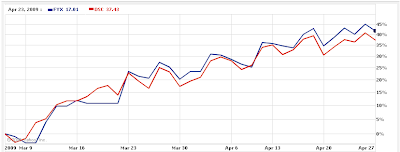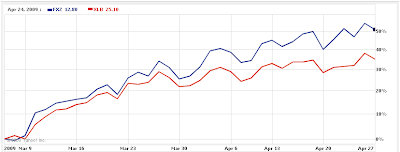I mentioned last week that I was seeing a group of AlphaDEX ETFs on the TradeRadar Trend Leaders list. I was not at all familiar with the name but since they were performing so well I felt they deserved a look. It turns out they are managed by First Trust and they are intended to provide superior performance by taking fundamentals into account when selecting the stocks that make up each style or sector portfolio.
Index Universe first wrote about these ETFs way back in 2007 (here's the link from Seeking Alpha).
Here's how Index Universe described the mechanics:
So the questions is, has First Trust succeeded in doing better than a standard cap-weighted index fund?
I took a selection of AlphaDEX funds (the ones that appeared on the Trend Leaders list this past weekend) and compared them with the corresponding SPDR ETFs managed by State Street Global Advisors.
Among the ones we looked at, it does appear that many of the AlphaDEX ETFs do indeed provide superior performance. The following charts show the gains since the March low for each of the ETFs with the AlphaDEX ETFs in blue and the SPDR ETFs in red. Click on any chart to view a larger image.








Conclusion --
Some of these ETFs do provide quite a margin of superior performance compared to the Select Sector SPDR ETFs and then some of them are pretty much just equivalent to the SPDRs. Judging by this sample then, it would appear that you can't really go wrong with the AlphaDEX family of ETFs in terms of returns though expenses tend to be higher than the SPDRs and volume is quite a bit lower.
The methodology does seem to add value when the stocks in the particular sector are showing the characteristics that their algorithm emphasizes. At the moment that seems to be consumer discretionary, consumer staples, materials and large-cap value. The benefit is less clear in the small cap, industrials, energy and financial sectors.
Overall, however, the AlphaDEX ETFs are worth consideration.
For more info on these ETFs: visit the First Trust site
Index Universe first wrote about these ETFs way back in 2007 (here's the link from Seeking Alpha).
Here's how Index Universe described the mechanics:
The methodology for enhancing those indexes is transparent, but complicated. The stocks in each index are divided into growth, core and value buckets. The growth stocks are evaluated by five metrics and given a score:The value stocks are evaluated by three metrics and given a score:
- three-, six- and 12-month price appreciation (i.e., momentum)
- one-year sales growth
- sales-to-price ratio.
The core stocks are evaluated on both metrics and the higher of the two scores is taken.
- book value-to-price
- cash flow-to-price
- return-on-assets.
So the questions is, has First Trust succeeded in doing better than a standard cap-weighted index fund?
I took a selection of AlphaDEX funds (the ones that appeared on the Trend Leaders list this past weekend) and compared them with the corresponding SPDR ETFs managed by State Street Global Advisors.
Among the ones we looked at, it does appear that many of the AlphaDEX ETFs do indeed provide superior performance. The following charts show the gains since the March low for each of the ETFs with the AlphaDEX ETFs in blue and the SPDR ETFs in red. Click on any chart to view a larger image.
FIRST TRUST LARGE CAP VALUE OPPORTUNITIES ALPHADEX FUND (FTA)
compared to SPDR Dow Jones Large Cap Value ETF (ELV)
compared to SPDR Dow Jones Large Cap Value ETF (ELV)
FIRST TRUST SMALL CAP CORE ALPHADEX FUND (FYX)
compared to SPDR Dow Jones Small Cap ETF (DSC)
compared to SPDR Dow Jones Small Cap ETF (DSC)
FIRST TRUST MATERIALS ALPHADEX FUND (FXZ)
compared to Materials Select Sector SPDR (XLB)
compared to Materials Select Sector SPDR (XLB)
FIRST TRUST CONSUMER STAPLES ALPHADEX FUND (FXG)
compared to Consumer Staples Select Sector SPDR (XLP)
compared to Consumer Staples Select Sector SPDR (XLP)
FIRST TRUST CONSUMER DISCRETIONARY ALPHADEX FUND (FXD)
compared to Consumer Discretionary Select Sector SPDR (XLY)
compared to Consumer Discretionary Select Sector SPDR (XLY)
FIRST TRUST INDUSTRIALS/PRODUCER DURABLES ALPHADEX FUND (FXR)
compared to Industrial Select Sector SPDR (XLI)
compared to Industrial Select Sector SPDR (XLI)
FIRST TRUST ENERGY ALPHADEX FUND (FXN)
compared to Energy Select Sector SPDR (XLE)
compared to Energy Select Sector SPDR (XLE)
FIRST TRUST FINANCIALS ALPHADEX FUND (FXO)
compared to Financial Select Sector SPDR (XLF)
compared to Financial Select Sector SPDR (XLF)
Conclusion --
Some of these ETFs do provide quite a margin of superior performance compared to the Select Sector SPDR ETFs and then some of them are pretty much just equivalent to the SPDRs. Judging by this sample then, it would appear that you can't really go wrong with the AlphaDEX family of ETFs in terms of returns though expenses tend to be higher than the SPDRs and volume is quite a bit lower.
The methodology does seem to add value when the stocks in the particular sector are showing the characteristics that their algorithm emphasizes. At the moment that seems to be consumer discretionary, consumer staples, materials and large-cap value. The benefit is less clear in the small cap, industrials, energy and financial sectors.
Overall, however, the AlphaDEX ETFs are worth consideration.
For more info on these ETFs: visit the First Trust site
Comments
Post a Comment